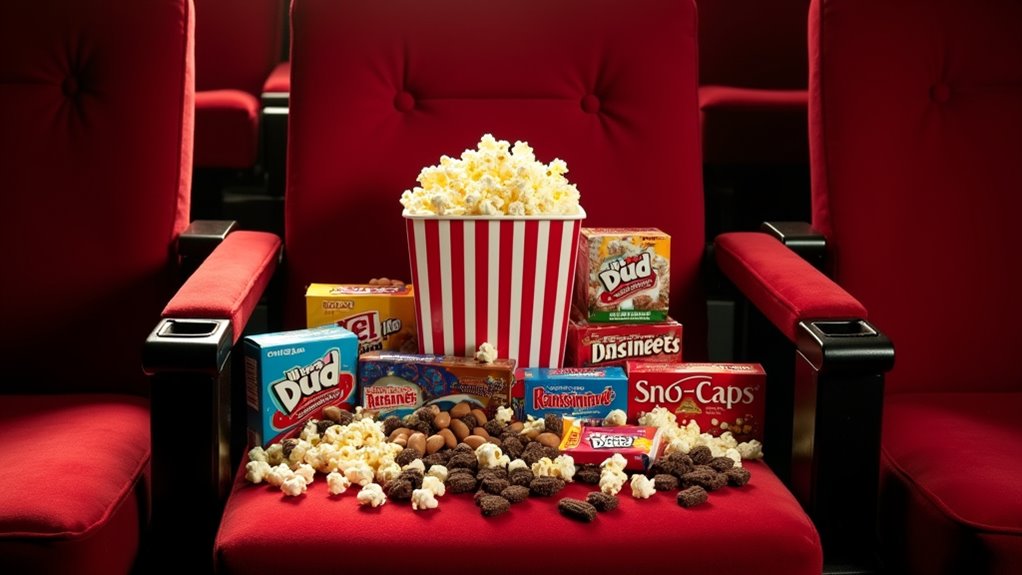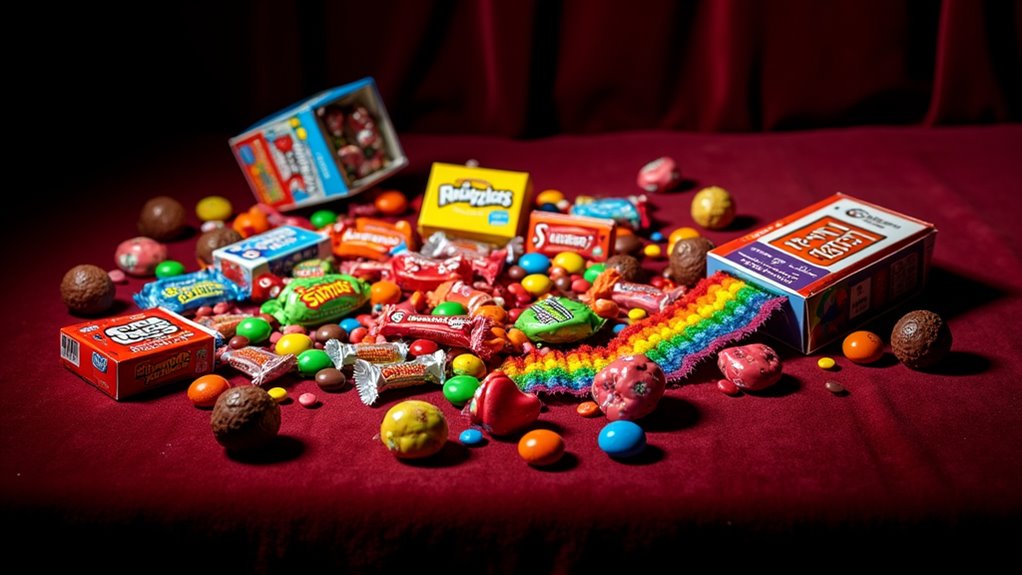Classic movie theater candies like Milk Duds, Junior Mints, and Raisinets have stood the test of time for good reason, offering the perfect mix of nostalgic flavors and convenient packaging. These timeless treats enhance the cinema experience through their shareable nature and strategic pairing with different film genres. The combination of chocolate-covered delights, chewy favorites, and fruit-flavored candies creates an immersive multi-sensory experience that transforms an ordinary screening into something extraordinary, with endless possibilities for taste adventures.
Top Movie Theater Candy Classics That Never Disappoint

When it comes to the timeless tradition of movie theater snacking, certain candy classics have earned their permanent place in cinema history. From the chewy delights of Milk Duds, first gracing theater counters in 1926, to the refreshing burst of Junior Mints that debuted in 1949, these confectionery staples have become as essential to the moviegoing experience as the silver screen itself. Since the 1920s and 1930s, theaters discovered that offering basic candy options significantly boosted their profits.
Leading the pack of time-tested favorites are Raisinets, which since 1927 have offered theater patrons a clever compromise between indulgence and health consciousness. Mixing these candies with sweet and salty popcorn creates an irresistible flavor combination that enhances the entire movie experience.
The distinctive crunch of Sno-Caps, with their signature nonpareil sprinkles, has been accompanying films since the Roaring Twenties, while Mike and Ike’s fruit-flavored chews have been brightening movie moments since the 1940s.
These enduring classics continue to prove that, much like the greatest films themselves, some things simply never go out of style.
How Movie Candies Enhance Your Cinema Experience
The strategic selection of movie candies transforms an ordinary film screening into a multi-sensory cinematic event that engages viewers beyond mere sight and sound. The careful pairing of sweets with specific film genres heightens emotional resonance, as the fizzy rush of Sour Patch Kids amplifies action sequences while the comforting chocolate of Milk Duds mellows dramatic moments. The theater-style boxes offer perfectly portioned treats that maintain the authentic cinema experience.
The social dynamics of candy sharing create a communal viewing experience, with iconic treats like Reese’s Pieces and M&M’s serving as conversation starters during slower scenes. All these classic candies have stood the test of time, with candy traditions beginning in the early 1900s.
Sharing movie candies creates social bonds, as beloved treats like M&M’s and Reese’s Pieces spark natural conversations between filmgoers.
Meanwhile, the ambient lighting of modern theaters complements the vibrant packaging of Swedish Fish and TWIZZLERS, creating an immersive atmosphere that enhances the storytelling experience.
Through thoughtful customization of snack combinations, viewers craft personalized taste adventures that parallel their chosen film’s journey, whether it’s the nostalgic charm of Red Vines during classic films or the excitement of mixing sweet and savory flavors during blockbuster premieres.
The Science Behind Our Favorite Movie Candy Cravings

Understanding movie candy cravings requires delving into a complex interplay of psychological, biological, and cultural factors that shape our snacking behavior during films.
Scientists have discovered that our brains release dopamine when we consume sugary treats, creating a reward system that keeps us reaching for more Milk Duds and Sour Patch Kids throughout the feature presentation.
This chemical reaction isn’t working alone, though. The whole movie-watching experience triggers multiple sensory responses, from the nostalgic aroma of chocolate to the satisfying crunch of candy-coated confections.
Our evolutionary instincts, which once guided our ancestors toward energy-rich foods, now drive us toward the concession stand. Moreover, the social aspect of sharing treats in a darkened theater creates positive associations that strengthen these cravings, while cultural conditioning has cemented certain candies as quintessential cinema companions, making them as much a part of the moviegoing ritual as dimming lights and rolling credits.
Frequently Asked Questions
Which Movie Candies Have the Longest Shelf Life at Room Temperature?
Hard candies and dark chocolate demonstrate superior longevity at room temperature, with dark chocolate maintaining quality for up to 2 years due to its high cocoa content and low moisture.
Traditional hard candies, those crystalline crowd-pleasers, clock in at roughly 12 months when stored properly in cool, dry conditions. Their molecular structure and minimal moisture content make them remarkably stable, outlasting their softer, more perishable counterparts.
Are There Any Movie Theater Candies That Are Exclusive to Certain Chains?
AMC Theatres has recently launched its own exclusive line called AMC Cinema Sweets, featuring gourmet chocolate-covered treats like pretzels, almonds, raisins, and peanuts.
This private-label initiative allows AMC to offer competitive pricing while maintaining control over their concessions.
While other major chains like Cinemark still primarily carry popular national brands such as Peanut M&M’s and Red Vines, AMC’s move represents a shift toward chain-specific candy offerings.
How Do Candy Prices at Theaters Compare to Regular Retail Stores?
Movie theater candy prices typically run 300-400% higher than retail stores, with theater boxes costing $3.99-$4.49 compared to around $1 at regular retailers.
This dramatic markup serves as a crucial revenue stream for theaters, who justify the premium through “convenience pricing” and specialized packaging.
Despite consumer complaints about the inflated costs, theaters maintain these prices since concessions represent a significant portion of their profits.
What Movie Candies Are Considered the Most Allergy-Friendly Options?
Several candies stand out as reliably allergy-friendly options, with Skittles leading the pack due to its freedom from common allergens like peanuts, tree nuts, and dairy.
Sour Patch Kids and Dots offer safe alternatives for those with dietary restrictions, while Dum Dums provide a classic lollipop experience without major allergens.
Red Vines and Swedish Fish round out the selection, though consumers should always verify current ingredients.
Can You Bring Outside Candy Brands Into Movie Theaters Legally?
Most movie theaters explicitly prohibit outside food and drinks, including candy, as part of their standard policies.
While some independent theaters may be more lenient, major chains strictly enforce these rules since concession sales represent a significant portion of their revenue.
Exceptions are sometimes made for medical necessities or severe allergies, but patrons should contact the theater in advance to discuss accommodation requirements.
